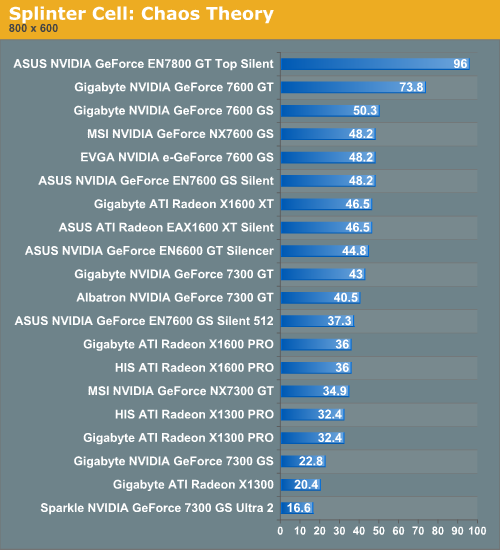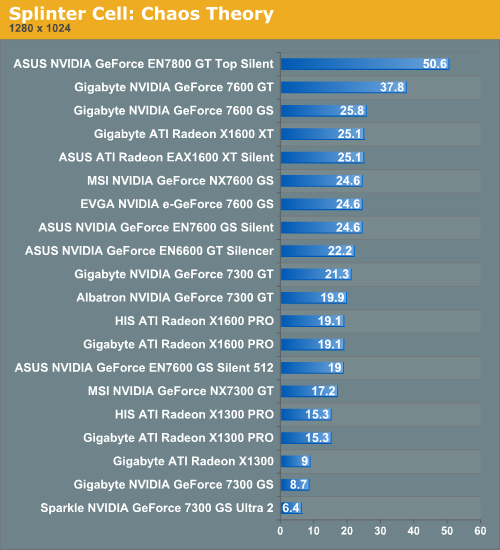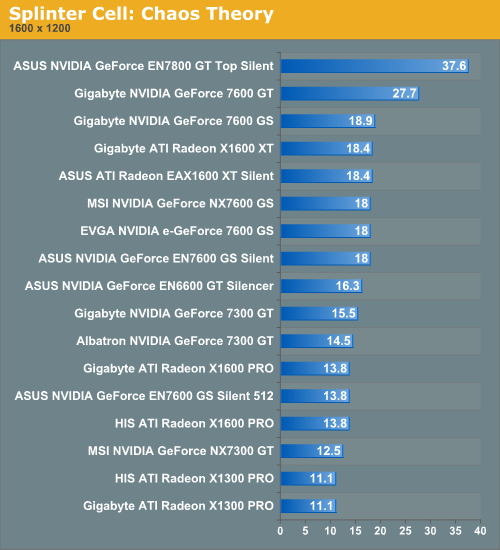Splinter Cell: Chaos Theory
Splinter Cell: Chaos Theory is a stealth-style game that has been around a while and that we've used many times for testing graphics cards. Because it's more of a slow-paced game and is mostly third-person, it can be enjoyed with a lower fps than fast-paced games like Battlefield 2 and Quake 4. Generally, a frame rate of about 20 FPS is as low as you would want to go when playing this game (depending of course on personal preference). The benchmark for this game is simply a recorded demo of the game play through the first level starting from the beach and ending at the first interrogation cell.




The first thing we notice is that unlike with Half-Life 2: Episode One, ATI hardware generally does a little better than NVIDIA with this game, and it's more noticeable on the low end. The Sparkle 7300 GS Ultra 2 has trouble running this game at all resolutions, but the 16.6 fps at 800x600 might be playable with this card, given the slower gameplay. Almost all of these cards won't be able to run this game smoothly at 1600x1200.
We can see that the X1600 XT performs very similarly to the factory-overclocked Gigabyte 7600 GS across all resolutions in this game, but the price for the Gigabyte 7600 GS is low enough right now that it would still be a better choice than the Gigabyte or ASUS X1600 XT, especially considering it will be a better choice for a lot of other games.
Splinter Cell: Chaos Theory is a stealth-style game that has been around a while and that we've used many times for testing graphics cards. Because it's more of a slow-paced game and is mostly third-person, it can be enjoyed with a lower fps than fast-paced games like Battlefield 2 and Quake 4. Generally, a frame rate of about 20 FPS is as low as you would want to go when playing this game (depending of course on personal preference). The benchmark for this game is simply a recorded demo of the game play through the first level starting from the beach and ending at the first interrogation cell.




The first thing we notice is that unlike with Half-Life 2: Episode One, ATI hardware generally does a little better than NVIDIA with this game, and it's more noticeable on the low end. The Sparkle 7300 GS Ultra 2 has trouble running this game at all resolutions, but the 16.6 fps at 800x600 might be playable with this card, given the slower gameplay. Almost all of these cards won't be able to run this game smoothly at 1600x1200.
We can see that the X1600 XT performs very similarly to the factory-overclocked Gigabyte 7600 GS across all resolutions in this game, but the price for the Gigabyte 7600 GS is low enough right now that it would still be a better choice than the Gigabyte or ASUS X1600 XT, especially considering it will be a better choice for a lot of other games.










49 Comments
View All Comments
Leo V - Thursday, August 31, 2006 - link
...I can buy a high-end 7800GT substantially cheaper, buy a quiet Zalman 80mm low-rpm GPU cooler and run it undervolted at 7V. (In fact, I have done exactly that.) It will be cheaper, run WAY cooler, and be quieter, because I can get rid of a case fan that I would need with a "silent" card anyway.The idea of running a 50-100watt GPU with a silent cooler is dubious -- you still need a fan somewhere in your system, and the best place is closest to the hottest parts. Those parts are naturally the CPU and GPU.
Instead of "silent" (but not really) high-end cards, give us cards with heatpipes + large, slow quiet fans that can be undervolted.
Most importantly, ATI and NVIDIA please stop making 100watt monsters and follow Intel's and AMD's lead in improving power efficiency.
yyrkoon - Thursday, August 31, 2006 - link
Sorry, I cant say I would agree that a fan would be quieter than a passive solution, I dont care if you could run it at 1V, and did :)Leo V - Thursday, August 31, 2006 - link
e.g. substantially cheaper than the holy grail "silent" version of the 7800GT.
And Kudos to the companies for the inventive products and to Anandtech for covering them.
hkBst - Thursday, August 31, 2006 - link
I've been waiting for a review of the passively cooled 7900GT from MSI for a while and I was expecting it to be in here. How can it not be?Look here: http://www.msi.com.tw/program/products/vga/vga/pro...">http://www.msi.com.tw/program/products/vga/vga/pro...
DerekWilson - Thursday, August 31, 2006 - link
We sent multiple requests for cards out to 16 different graphics card manufacturers. I'd say we did pretty well with more than half of those responding.We also requested that each manufacturer send us all their passively cooled cards. If something was left out it was either because the manufacturer decided not to send it, or we weren't able to get ahold of it before our submission deadline. We tested a lot of cards and have been working on this for quite some time, so silent cards that have come out recently or were not widely available until recently will not have been included.
JarredWalton - Thursday, August 31, 2006 - link
Also, the MSI 7900GT Silent card is only available in Europe, and we did mention this in the review.haris - Thursday, August 31, 2006 - link
Any chance you could retest the cards using a mid range system. It seems kind of silly to test an FX-55 with a $50-100 video card.nullpointerus - Thursday, August 31, 2006 - link
Yet Another Silly Performance Retest Request (YAMPRR)Testing an FX-55 with a $50-100 video card is not silly; testing graphics cards' performance relative to each other requires removing all other factors including the CPU and RAM. Not everyone has a "mid-range" system, and those who do not have a "mid-range" system do not want the results skewed just to make your life easier. If you want specific performance advice for your particular system and games, why do you not join and post in the forums?
ss284 - Thursday, August 31, 2006 - link
Well considering the majority of people who are looking for midrange graphics cards have a midrange system, his request is a perfectly good one. Unless Anandtech enjoys targeting the minority of its readers it should be doing more applicable performance testing. Then again, the FX-55 isnt exactly a cutting edge processor anymore. Just scale everything back 10% and you will have a rough estimate of what performance would be like on a mid range system.nullpointerus - Thursday, August 31, 2006 - link
Yet Another Defense of a YAMPRR (YADY). *yawn*Well considering the majority of people who are looking for midrange graphics cards have a midrange system, his request is a perfectly good one.
No, it's a silly one. The point of the article is to compare graphics cards, not to make life easier for a certain group of people. People who follow this esoteric stuff religiously tend to distill the information into a more practical form. And as I said, the information he wanted is readily available in the forums. A couple of mouse clicks and a bit of typing is better than ignorantly saying the video card article is silly for not providing framerates similar to some mythical ideal of a mid-range system.
Unless Anandtech enjoys targeting the minority of its readers it should be doing more applicable performance testing.
How about you go where the information is normally provided instead of trying to turn all the front page articles into your personal system upgrade newsfeeds?
Could we just skip ahead to where everyone chimes in with their own ideas of what a mid-range system is. Does it use AMD or Intel? Single or multi-core? How much RAM? Which timings? Which system boards? Which components are overclocked?
I'll make a deal with you: get together a mid-range system that everyone will agree on, and then I will agree with you that we should conflate graphics cards testing with mid-range system testing. You see, ridding the comments section of silly YAMPRR and YADY posts will not benefit anyone if we still have to deal with all the senseless bickering about little details such as chipset revisions, features, and all the other inane griping I have seen posted when Anandtech picks out a CPU, overclocking, or RAM configuration as representative of X-range systems.